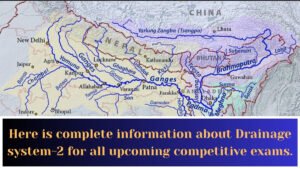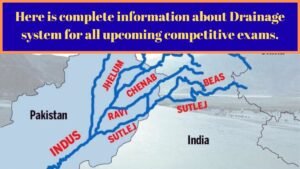Drainage system-3:Information with questions and answers about Drainage system-3 for GPSTR, HSTR, TET, CTET, teacher recruitment competitive exams.

1. The highest drainage basin associated with the peninsular river in India is
1) Mahanadi
2) Godavari
3) Krishna
4) Narmada
Ans:-2) Godavari
• Godavari River:- The longest and largest river in alternative India is Godavari.
• It originates at ‘Triambakeshwar’ in Nashik district of Maharashtra state. It flows for about 1465 km through the states of Maharashtra and Andhra Pradesh and empties into the Bay of Bengal at Kakinada (Andhra Pradesh).
• The major tributaries of the Godavari River are the Purna, Penuganga, Pranahita, Sabari, Indravati and Manjra.
• The Godavari River delta is dotted with numerous canals and mangrove forests dotted with lagoons.
• Kolleru Lake is a lagoon island.
————————————————————————–
2. The only perennial river in Peninsular India is ———
1) Godavari
2) Kaveri
3) Krishna
4) Bhima
Ans:- 2) Kaveri
• The Cauvery is the only perennial river in the Indian peninsula. However, it is not snow-fed like the rivers of North India.
• The Cauvery receives rainfall throughout the year, mainly due to the occurrence of the northeast monsoon in Tamil Nadu & flows as a perennial river in South India due to the southwest monsoon.
• Cauvery River:- Total length: 765 km, 380 km in Karnataka,
• Distribution:- Karnataka, Tamil Nadu, Kerala and Pondicherry.
• Tributaries:- Left bank: Harangi, Hemavati, Shimsha, Arkavati
• Right Bank:- Kabini, Bhavani, Noyala, Amaravati, Moyar, Lakshmanatirtha
————————————————————————–
3. Which of the following water bodies is not a freshwater resource ?
1) Jaisamand
2) Ganga river
3) Yamuna river
4) Chilika Lake
Ans:- 4) Chilika Lake
• Fresh water is a renewable resource.
• The Ganges River, Yamuna River, and Jaisamand Lake fall under this category.
• Chilka Lake is the largest saltwater lake in India. It is spread across the Puri, Khurda and Ganjam districts of Odisha and is a part of the Daya River.
• It became India’s first protected wetland on 1st October 1981, when it was included in the Ramhar wetlands. It is the 2nd largest lake.
Specialties of Lakes:-
• Wullar Lake: One of the largest freshwater lakes in Asia and was formed as a result of tectonic activity.
• Vembanad Lake:- It is the longest lake in India.
• Cholamu Lake (Sikkim) – The highest lake in India.
• Lonar Lake:- Located in the Bullana district of Maharashtra, it is formed from a meteorite.
• Udaipur is known as the city of lakes.
————————————————————————–
4. Bhakra Nangal Project is constructed across which river?
1) Ganga
2) Sutlej
3) Cauvery
4) Brahmaputra
Ans:- 2) Sutlej
• Bhakra-Nangal Project: One of the most important multipurpose river valley projects in India. It is a joint project of the states of Punjab, Haryana and Rajasthan. The construction of this project started in 1948 and was completed in 1963 at a cost of Rs. 235 crore.
• The Bhakra Dam was built in the Bhakra Valley of Himachal Pradesh, just before the Sataj River enters the plains of Punjab.
• This valley is located in the foothills of the Himalayas. The reservoir formed by this ridge is named ‘Govinda Sagar’.
————————————————————————–
5. Which was the first hydel power project in India?
1) Pallivasal in Kerala
2) Paikara in Tamil Nadu
3) Shivana Samudram in Karnataka
4) Nizamnagar in Andhra Pradesh
Ans:-3) Shivana Samudram in Karnataka
• The 4.5 MW hydroelectric power station near the Shivanasamudra Falls on the Cauvery in Karnataka is India’s first major power station.
• Owned by some British companies, it was founded by General Electric of the US.
• It was commissioned in 1902. It is the first small hydroelectric power plant.
• Shivanasamudra Falls is created by the Kaveri River.
• The island town of Shivanasamudra divides the Cauvery River into twin waterfalls (Gaganachukki & Bharachukki).
• The first hydroelectric power station in Asia was established in 1902 at Shivanasamudra (Shimsha) across the Cauvery River.
• Cauvery:- It is called the “Ganges of South India”. It originates in Talakaveri in the Brahmagiri hills of Kodagu district. It flows for a distance of 805 km. However, it flows for a distance of 380 km in Karnataka.
• States:- Karnataka, Tamil Nadu, Kerala & Pondicherry.
• Left bank tributaries:- Harangi, Hemavati, Shimsha and Arkavati.
• The right bank tributaries are:- Lakshmana Tirtha, Kabini, Suvarnavati, Bhavani, Noil and Amaravati.
• Shivana Samudra:- (Established in 1899-1900) Built during the reign of Nalvadi Krishnaraja Wodeyar of the Mysore State.
• Diwan of Mysore – Sheshadri Iyer
• This is the first power plant in Asia.
• Reason for establishment:- To provide electricity to the gold mines of Kolar. In 1905, Bangalore city got this facility and became the first city in India to be lit by electricity.
————————————————————————–
Drainage system-3:Information with questions and answers about Drainage system-3 for GPSTR, HSTR, TET, CTET, teacher recruitment competitive exams.
6. Ahmadabad is situated along the bank of
1) Sabaramati river
2) Narmada river
3) Banas River
4) Luni river
Ans:- 1) Sabaramati river
• Ahmedabad is located on the banks of the Sabarmati River in Gujarat.
• The river flows through the center of the city and divides it into two physically distinct eastern and western areas.
• This river originates in the Aravalli range in Udaipur district of Rajasthan.
————————————————————————–
7. What is Talcher important for?
1) Heavy water plant
2) Hydro-electricity generation
3) Cable industry
4) Atomic reactor
Ans:-1) Heavy water plant
• Taltar, located in Angul district of Odisha, is famous for its heavy water plant.
• This plant is a Government of India institution under the Ministry of Atomic Energy & Power.
Major Cities & Industries in India
• Karnataka: Mysore-silk, Channapatna-wooden toys, Ramanagara-Yelahanka railway junctions. Silk,
• Madhya Pradesh:- Gwalior-pottery industry, Cotton-cement, Nepanagar-newspaper.
• Assam:- Diggai-Petroleum, Noonmati-Oil Refining.
• Jharkhand:- Dalmia Nagar – Cement, Gemsheddura-Iron & Steel, Zharia-Coal, Sindri-Fertiliser, Bokaro-Iron & Steel.
• Punjab:- Dhariwal: Wool industry, Nangal: Fertilizer
• Andhra Pradesh:- Singareni: Coal, Guntur: Cotton, Chilli.
————————————————————————–
8. Govind Ballabh Pant Sagar reservoir is situated in:
1) Chhattisgarh
2) Jharkhand
3) Uttarakhand
4) Uttar Pradesh
Ans:- 4) Uttar Pradesh
• Rihand Dam, also known as Govind Ballabh Pant Sagar, is a concrete gravity dam located in Pimpri, Sonbhadra district of Uttar Pradesh, whose reservoir area is on the border of Madhya Pradesh and Uttar Pradesh.
• It is built on the Rihand River, a tributary of the Son River.
————————————————————————–
9. Which of the following rivers originates from Trans Himalayas ?
1) Yamuna
2) Sindhu
3) Saraswathi
4) Ganga
Ans:- 2) Sindhu
• Trans-Himalayan rivers originate beyond the Great Himalayas. They are the Indus, Sutlej and Brahmaputra rivers.
• Indus River:- It originates at an altitude of 4164 m in the Bokharchu Glacier near Lake Manasarovar in the Kailash mountain range of Tibet. In Tibetan, it is called ‘Singha Kamban’ (Lion’s Mouth).
• Brahmaputra:- Originates from the Chemyangdung glacier near Lake Manasarovar in the Kailash mountain range.
• Sutlej:- Originates in Rakus Lake, Manasarovar (Dharma Pass) in Tibet.
————————————————————————–
10. Which of the following states in known as the traditional region for Tank Irrigation?
1) Assam
2) Gujarat
3) Tamil Nadu
4) Orissa
Ans:-3) Tamil Nadu
• Tank Irrigation: South India does not have perennial rivers like North India. This part gets irrigation facilities or water availability due to rainfall during the southwest and northeast monsoons.
• Tanks are built to collect rainwater and store it for its beneficial use.
• The water stored in the tank is used for crop irrigation, groundwater recharge, domestic use, watering livestock, etc.
• Currently, more than 30% of all irrigated cropland in the states of Tamil Nadu and Karnataka is under tank irrigation.
• Tamil Nadu has the largest number of tank irrigation projects.
————————————————————————–
Drainage system-3:Information with questions and answers about Drainage system-3 for GPSTR, HSTR, TET, CTET, teacher recruitment competitive exams.

11. Which state of India has made rain water harvesting compulsory for all houses ?
1) Haryana
2) Maharashtra
3) Tamil Nadu
4) Punjab
Ans:- 3) Tamil Nadu
• Rainwater harvesting has been made mandatory for every building in Tamil Nadu to avoid groundwater depletion. After its implementation, Chennai saw a 50 percent increase in water levels in five years. The water quality improved significantly.
• Rainwater harvesting is the process of collecting and storing rainwater for reuse instead of allowing it to run off.
————————————————————————–
12. Through which states does the river Chambal flow?
1) Rajasthan, Madhya Pradesh, Bihar
2) Uttar Pradesh, Madhya Pradesh, Rajasthan
3) Madhya Pradesh, Gujarat, Uttar Pradesh
4) Gujarat, Madhya Pradesh, Uttar Pradesh. Bihar
Ans:- 2) Uttar Pradesh, Madhya Pradesh, Rajasthan
• Chambal River is the main tributary of Yamuna River.
• It originates in Mo, west of the Vindhya Mountains, and flows for 1050 km through Madhya Pradesh, Rajasthan, and Uttar Pradesh before joining the Yamuna River in Etawah district.
• Yamuna River:- Originates from the Yamanotri Glacier in the Garhwal region of Uttarakhand. It is the largest tributary of the Ganges River. It joins the Ganges River at Prayag (Allahabad).
• Right bank tributaries:- Chambal, Sindh, Betta and Kane
• Left bank tributaries:- Hindon, Hynd, Sengar and Varuna.
————————————————————————–
13. Which among the following Indian river flows westwards and falls into Arabian sea?
1) Narmada
2) Ganga
3) Mahanadi
4) Godavari
Ans:- 1) Narmada
• Rivers that flow into the Arabian Sea in the West Among the rivers that originate in the Indian subcontinent and flow westward to join the Arabian Sea, two systems are most important.
• Rivers that flow into the Bay of Bengal:- Paleru, Pennar, Godavari, Kaveri, Krishna, Malaprabha, Ghataprabha, Mahanadi, Bhima, Tungabhadra, [Papa Gokaka Magham Bithu]
• Rivers that flow into the Arabian Sea:- Sabarmati, Narmada, Tapti, Mandovi, Kali, Sharavati, Periyar, Netravati. [Sanat Maa Kashapane]
Rivers in Karnataka
• Rivers that flow into the Bay of Bengal:- Hemavati, Lakshmana, Arkavati, Krishna, Kaveri, Malaprabha, Ghataprabha, Harangi, Tungabhadra, Bhima. [The rivers that flow into the Bay of Bengal are Hemavati, Lakshmana, Krishna, Kaveri, Magha, Harangi]
• Rivers that join the Arabian Sea:- Sharavati, Netravati, Kali, Varaha, Bedti, Aghunashini, [Shenek Varabedi crossed Aghunashini]
————————————————————————–
14. Which of the following is not a water harvesting method used Rajasthan?
1) Johads
2) Khadins
3) Guls or Kuls
4) Tanka
Ans:- 3) Guls or Kuls
• Some of the water harvesting methods used in Rajasthan are: Kunds/Kundis, Kuis/Beris, Baris/Bars, Jalaras, Nadis, Tobas, Tankas, Khadin, Bao/Bawadi, Virdas, Johads Kuls & Guls are water harvesting methods used in the hilly regions of the Himalayas.
————————————————————————–
15. Which one of the following is the largest freshwater lake in India?
1) Dal Lake
2) Pulicat Lake
3) Wular Lake
4) Titicaca Lake
Ans:- 3) Wular Lake
• Wular Lake in Bandipora district of Jammu and Kashmir is the largest freshwater lake in India. The size of the lake, fed by the Jhelum River, varies seasonally from 30 to 260 sq km.




